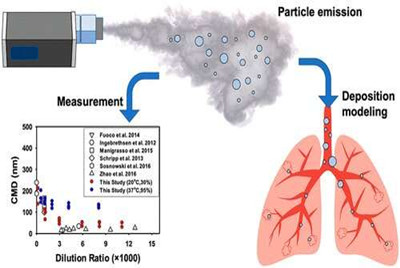
E-cigarette use is rising, particularly among young adults and teens. Recent illnesses and deaths attributed to vaping have caused intense scrutiny of the chemicals in e-liquids and vapor, but little is known about the size of vaping particles and their deposition patterns in human airways. Now, researchers reporting in ACS' Chemical Research in Toxicology have analyzed how e-cigarette particle size and deposition change with factors such as device power, e-liquid composition and vaping practices.
Unlike regular cigarettes, which burn tobacco to produce smoke, e-cigarettes are battery-powered devices that heat an e-liquid to form an aerosol, which the user inhales. E-liquids typically contain nicotine, flavoring agents and a base material, such as vegetable glycerin or propylene glycol. Because e-cigarettes do not combust tobacco, they are thought to be less harmful to human health than regular cigarettes. However, actual health risks are not well understood. Therefore, Qingyu Meng and colleagues wanted to investigate the particles produced by vaping, which typically consist of liquid droplets of the base material, and how they might be deposited in human airways.
The team observed vaping sessions of 23 volunteers and used these findings to simulate human vaping with a smoking machine. The researchers then collected the aerosol and measured particle size distribution. They also tested the impact of various factors. Among their results: higher device power settings and the use of vegetable glycerin-based e-liquids produced larger particles than lower settings and propylene glycol-based liquids. Also, at a fixed puff volume, longer puff durations (in other words, slower air flow) generated significantly larger particles. The researchers estimated that most of the particles were deposited in the lower respiratory tract (the trachea and bronchi), whereas a smaller amount entered the deeper bronchoalveolar regions of the lungs. Although e-cigarette particles were smaller and less abundant than those generated by regular smoking, they have similar human airway deposition patterns, the researchers say.

